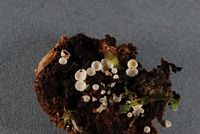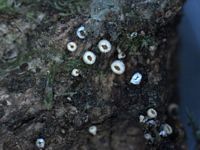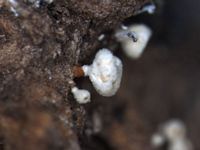|
 Lachnum berggrenii Lachnum berggrenii
BiostatusPresent in region - Indigenous. Endemic
Images (click to enlarge)
Caption: Apothecia (fresh)
Owner: Herb PDD | 
Caption: Apex of paraphyses
Owner: Herb PDD | 
Caption: Apothecia (dry)
Owner: Herb PDD | 
Caption: Base of stipe consistently lacking hairs.
Owner: Herb PDD | 
Caption: Figure 110. Lachnum berggrenii, holotype. A. Apothecium. B. Ascospores. C. Asci and
paraphyses. D. Hairs. |
Article: Spooner, B.M. (1987). Helotiales of Australasia: Geoglossaceae, Orbiliaceae, Sclerotiniaceae, Hyaloscyphaceae. Bibliotheca Mycologica 116: 711 p.
Description: APOTHECIA 0.8-1.5 mm diam., scattered, superficial, short-stipitate. DISC concave, pale
orange-brown, smooth. RECEPTACLE cupulate, concolorous, clothed with whitish hairs,
sometimes pale brownish in dried apothecia. STIPE central, usually slightly tapered, shorter
than disc diameter, concolorous, often smooth near the base. HAIRS mostly 60-90 x 2.5-3.5
µm, hyaline, cylindric, usually flexuous, obtuse, thin-walled, septate, finely granulate
throughout and bearing abundant particles and irregular masses of yellow-brown or amber
coloured resinous matter. ASCI (80-)90-100 x 7-8 µm, 8-spored, narrowed at the base, apex
conical, the pore strongly blue in Melzer's reagent. ASCOSPORES 13-20 x 2.2-2.8, mean 15
(SD 1.3) x 2.6 (SD 0.1) µm, hyaline, fusoid, straight, often slightly inequilateral, containing a
row of guttules, non-septate, irregularly biseriate. PARAPHYSES cylindric or rarely
narrowly lanceolate, tapered and usually pointed at the apex, sparsely septate, sometimes
branched, hyaline, 2 .0-2.5 µm diam., scarcely exceeding the asci. SUBHYMENIUM not
clearly differentiated. MEDULLARY EXCIPULUM composed in the stipe of vertically
oriented, undulating and slightly interwoven hyphae 2-3 µm diam., continuing into the
receptacle and forming at the centre and in a narrow layer in the flanks, a compact textura
intricate of slightly narrower hyphae 1.5-2.0 µm diam. A compact layer of similar, parallel
hyphae lies adjacent to the ectal excipulum. ECTAL EXCIPULUM a compact, hyaline layer
25-30 µm thick, composed of narrow, prismatic cells mostly 12-20 x 3-4 µm, with thin or
slightly thickened walls, lying in rows at a low angle to the surface.
Habitat: On dead bark. Known only from the holotype collection.
Notes: DERIVATION: Named in honour of Sven Berggren, collector of the type material.
This collection by Berggren is partially annotated by Cooke and has been previously
determined as Dasyscypha nivea, from which it is clearly distinct in the larger spores and
completely granulate hairs. Apothecia occur on fragments of undetermined bark and are,
unfortunately, in a comparatively poor state of preservation. Dried apothecia are frequently a
unicolorous orange-brown, and the hairs are difficult to observe. The structure of the excipular tissue is also
difficult to interpret, the hyphae now being collapsed and compacted, and further collections
are required to confirm or amplify the description given above. The ectal cells are prismatic
and more or less thin-walled and the structure appears to be typical of the genus. Fortunately,
the apothecia are fully mature and yield abundant spores, and the species should prove readily
recognizable. It is distinguished by the fusoid spores, narrow paraphyses and hairs bearing
abundant particles of yellowish-brown, resinous matter.
Lachnum berggrenii is perhaps related to L. lachnoderma, but has shorter and broader,
non-septate spores and narrower paraphyses. The spores are remarkably similar to those, of
L. filiceum, but that is a distinctive species occurring exclusively on ferns and having shorter,
unencrusted hairs and lanceolate paraphyses.
|